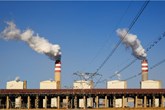Showers but with a chance of sun
Published by Harleigh Hobbs,
Editor
World Coal,
Hal Quinn, President and CEO, National Mining Association.
The current state of the US coal industry is a microcosm of a global market for coal still ailing from unfavourable macroeconomic trends. This year will extend a difficult period of capacity adjustments that US producers are making to align production with more modest demand scenarios. US coal production, last year, was down 10% from 2014 and is expected to decline further this year, based on preliminary data from the US Energy Information Administration (EIA). The number of active mines has fallen but the number of operating sections within the mines has fallen further.
The EIA’s parsing of coal demand explains why. Demand from all sectors, last year, fell by 13%. Coal exports, for example, declined sharply in 2015, down 23 million short t from 2014 to approximately 74 million short t. In addition to the impact from Asia’s slowing economies, US shipments to the EU, traditionally a major destination for US coal, declined by 28%.
Adding significantly to the oversupply challenges has been the competition from unexpectedly low natural gas prices. Today, natural gas generates almost as much electricity as coal, even as coal remained the domestic market leader last year, generating more than 34% of the nation’s electricity.
The suddenness and steepness in the decline in demand for coal has had an indiscriminate effect on US coal producers. Many were deep into a new investment cycle, acquiring new capacity in anticipation of growing offshore demand. The resulting burden of debt service has added to the challenges of producers as they struggle with soft and shifting markets.
Further impacting coal domestically is the growing saturation of renewable generating capacity fuelled by generous tax policy that encourages solar and wind investment. Offshore, a strong dollar against world currencies has made US coal exports less competitive relative to other coal supplying regions.
US government policies have also played an outsized role in the dramatic change we see in the outlook for domestic coal. Beginning with the Mercury and Air Toxics Standards (MATS) for power plants in 2011, regulations have contributed to the loss of at least 33 GW of coal generating capacity in addition to more expected to be retired this year. For example, the administration’s Clean Power Plan, designed to reduce carbon dioxide emissions from coal-fired power plants, is expected to double the capacity already lost to fuel switching and prior regulations, while triggering double digit increases in wholesale electricity costs and adding US$216 billion to the nation’s utility bill by 2030.
Other rules aimed at coal production could render a substantial amount of US coal reserves inaccessible. A proposed three-year moratorium on coal produced from federal lands largely in the West will throttle production from the largest source (43%) of total domestic production. Higher royalties and fees on government coal leased at auction may follow.
The toll of these policies demonstrates the steep price of keeping coal in the ground. The US has lost about 40 000 coal mining jobs since 2011 and many tens of thousands more that coal supports throughout the supply chain – from mines and power plants to railroads and ports.
Fortunately, the effects of policy, like the effects of market forces, are not immutable. A presidential election year in the US offers our industry, its employees and its varied allies the opportunity to vote in a government with a more balanced energy policy and hopefully see out many of the damaging policies from this government.
Change may well be coming in the marketplace, too. The commodity cycle that didn’t stop at the top will not stop at the bottom either. Global demand for coal is likely to pick up next year, albeit at a gradual pace initially with more rapid growth in the years thereafter. World Bank President Jim Yong Kim reminded member country representatives last month that the bank expects “a marked increase of coal consumption” in coming decades.
Elsewhere we see sustainable improvements for domestic coal. The introduction of new safety technologies and practices helped US coal mining achieve a record safety year in 2015. Companies that adopt the National Mining Association’s own CORESafety™ initiative, wholly or in part, can document improved safety performance that results from following the programme’s best practices.
Similarly, the environmental performance of our industry continues to improve. Our fleet average reduction of conventional pollutants per unit of electricity – 90% since the 1970s – rivals the achievement of any industry. By 2019, the US coal-fired power industry will have invested more than US$126 billion in emission reductions, leaving a fleet that is more efficient and cleaner than ever before.
Our commitment to high-efficiency, low-emissions (HELE) technologies remains a more rational and sustainable solution for addressing climate change concerns than an approach based on ending coal’s use. Missing from this strategy, we believe, is an effective approach for addressing either the environmental issues of affluent nations or the pressing economic concerns of emerging countries seeking their rightful place among rich ones.
So, for 2016, the forecast for US coal is for continuing showers, heavy at times, with possible sun in the near future.
Written by Hal Quinn, National Mining Association. Edited by Harleigh Hobbs. This article first appeared in World Coal June. To read this and much more, register to receive a copy here.
Read the article online at: https://www.worldcoal.com/special-reports/10062016/showers-but-with-a-chance-of-sun-941/
You might also like
FutureCoal welcomes US investment in modernising coal plants
FutureCoal welcomes the US administration’s US$625 million investment to upgrade and modernise coal plants, calling it a pragmatic step forward to achieve energy security and best environmental performance.

